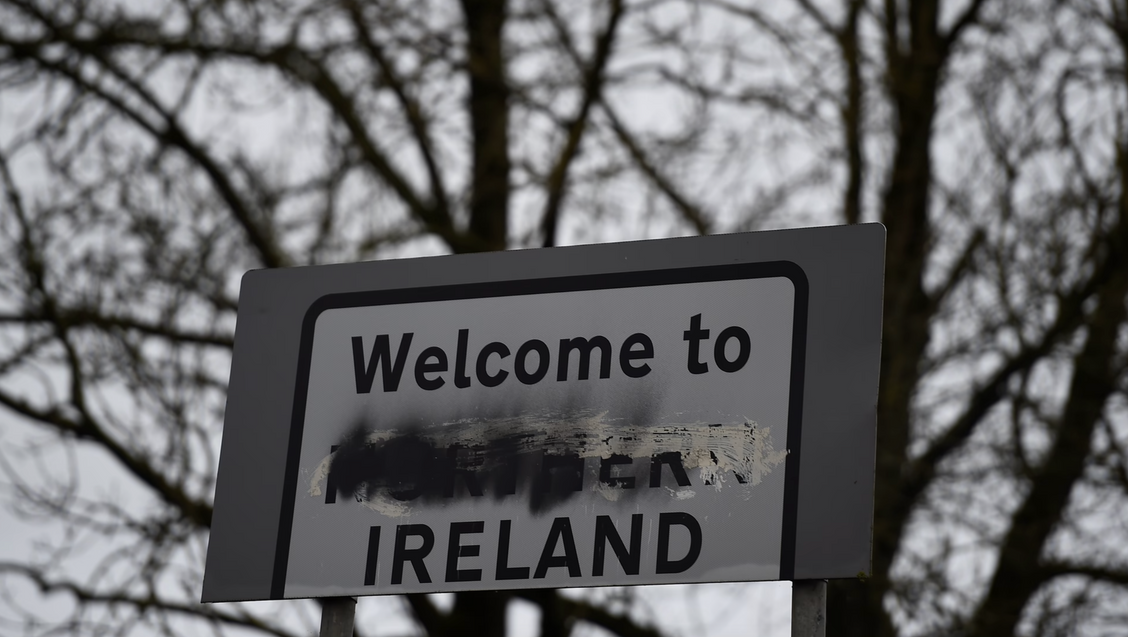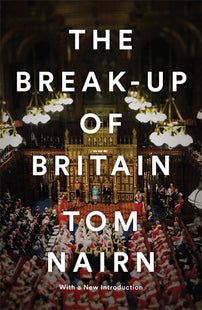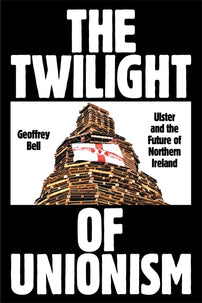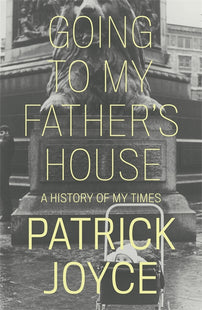All-Ireland Consciousness
The 2016 Brexit referendum cracked much of the artifice of the Irish border, reigniting debates on partition and reunification on the island. Colin Gannon reports on the chances for, and stumbling blocks to, a renewed all-Ireland consciousness on the Irish left.

Partition has long been a structuring principle of Irish political and cultural life, seeping into and conditioning everything on the island. Until Brexit cracked much of the border’s artifice, Northern Ireland—as a political unit—had been seemingly thoroughly naturalised. After the 2016 vote, however, the political establishment in the South was reluctantly forced to engage with the politics of partition, a bogeyman of the statelet's anti-republican ruling class. Today, sanguine Irish socialists and left republicans preach the necessity of constructing a New Ireland during this reputedly pre-epochal moment. But if there is a void where the discussion on the form of this New Ireland should be, there is even less debate on how we get there. The ultimate tragedy would be one in which a geographical border is simply dismantled, the Northern rump merely subsumed into the South, the legacies of partition left untouched. As Stephen O’Neill has so movingly written, unforgetting the “violence and turmoil” that accompanied partition, and challenging the “myths and elisions” of the dominant partitionist narratives, necessitates “thinking about how partition still actively conditions the everyday life of the island.” For the radical left, this message should be especially resonant.
But it is worth asking: where can we locate the political inflection points from which a movement, or collection of movements, aspiring for a radical unification might emerge? What are the early signs, if any, of genuinely all-Ireland solidarities and alliances, indispensable to any unification campaign which claims newness and emancipation? Incipient traces of what we might call an “all-Ireland consciousness” are surfacing, but they remain underdeveloped, inhibited by partionistist mindsets and stark capitalist development divides; between a form of super-charged neoliberalism on a constant drip-feed of international capital and a stagnant, postindustrial, Northern economy dominated by the public sector; between a molecular process of post-crash radicalisation in the South and the persistence of communal political loyalties in the North. In such a bleak political context, all-Ireland organisation is the only way forward.
As yet, there has been no serious attempt to track the broader Irish left’s current trajectory, nor to consider these subterranean shifts beyond the high watermarks of national and local elections. On both sides of the British-drawn border, fissures in the hegemonic order have been framed by elections and electioneering, voting patterns and demographics, opinion polls and mood music. Little effort has been made to look beyond and engage with extra-parliamentary forces across the island. Fewer still have sketched a way forward for an all-Ireland left, appraising the radical possibilities of new solidarities and synergies as unification shifts onto the political horizon. This is especially relevant given the island's schizophrenic responses to COVID-19, as well as the general economic integration that has accelerated since 1998. Interconnected now more than ever, trade between the North and South was £7.1bn in 2019—a sharp increase from 2011 when the figure was £4.5bn. On a more quotidian level, an estimated 30,000 people cross the border to work each day.
Hastened no doubt by Brexit, this subtle integration has come against the backdrop of an ascendent Sinn Féin. In the South, one recent Red C poll gave them 36%, slightly ahead of the combined support for the traditional political powerhouses, Fine Gael and Fianna Fáil, both of which have juggled governance of the southern state since 1922. Meanwhile, in Belfast, the party recently broke new historic ground. May’s Assembly election saw Sinn Féin become, for the first time, the largest party at Stormont. Amid the international clamour that surrounded the result, less-heralded was the preservation of the position of the all-Ireland Trotskyist party People Before Profit (PBP), whose West Belfast incumbent, Gerry Carroll, retained his seat. Although they failed to take their targeted second seat in Derry, the result—while unextraordinary—guarantees a socialist voice in the Assembly and, in contrast with the Green Party’s misfortunes (who lost both of their seats, including that of their leader, Clare Bailey), is not a complete disaster.
[book-strip index="1" style="buy"]Alongside this decent Northern showing, the South has, as Daniel Finn has written, rather inexplicably turned out to be the “last stronghold of European Trotskyism”. While the country’s PR-STV voting system greatly favours minor parties, they have punched far beyond their weight in Irish politics. In the 2020 elections in the south, Solidarity–People Before Profit held onto five of their six seats. Not only were they the sole national party to align themselves with the mutinous water charges campaign, they stood out as the only party to show full-throated support for abortion rights. There is a strong case to be made that such strength, however relative, could serve as a bulwark against a rightwards lurching Sinn Féin. Also notable is their presence across the island and—despite doctrinaire quibbles in the past over the National Question—their now firm support for Irish unification. Any prospective all-Ireland social movements worth their salt may not need, but would unquestionably benefit immensely from the unequivocal support of at least one national party, and were it to come it would most likely be from PBP – a party who could also inject a much-needed Marxist perspective into any ‘Pink coalition’ in the South involving all of the parties to the left of Fine Gael and Fianna Fáil.
Flying vertiginously high in the polls, Sinn Féin is now preening itself as the next government in the South, the first time they have been able to do so. Yet fortunes of the Irish left beyond Sinn Féin, in most orthodox analyses at least, are a mere footnote. Michael Taft, a researcher for Ireland’s largest trade union, SIPTU, calls for a rejection of maximalism: what he defines as the “temptation to list all the crises (and there are many), develop policy responses, package them together and call it an alternative.” In his view, a motley bloc of progressive forces—Sinn Féin, the Labour Party, the Social Democrats, People Before Profit, Solidarity, RISE and Right to Change—must “stake out new ground by packaging their programme as common sense policies.” Adding that the left must broadcast its electability first and foremost, this argument belies a managerialist tendency: if only Sinn Féin and its progressive peers were better communicators and parliamentarians, the Irish left would become an eminently more electable force. No mention here of building popular pressure from below, to say nothing of the spectre of unification or ending partition––the enormous, 101-year-old elephant in the room.
The question that Robbie McVeigh and Bill Rolston ask in their recent book, Ireland, Colonialism and the Unfinished Revolution, is how might the Irish left organise to end partition to radically reformist ends. In offering some insight on the possible strategic way forward, they draw our attention to the late nineteenth-century Parnellite popular front, which was composed of three different strands: insurrection; mass mobilisation; and representative democracy. Conceding that this is an “optimistic template”, and fully aware of its inherent anachronism, they are right to say that “any broader rejuvenated republicanism cannot depend on Sinn Féin alone”. The historical model of the Parnellite popular front is instructive not for its replicative potential, but for its precedent of marrying various republican, nationalist and anti-capitalist traditions. Enlisting everyone from Fintan O’Toole—pious oracle of Irish liberalism—to sidelined dissident republicans would, their thinking goes, “release a world of engagement with the question of what a new republic might—and should—look like.” But from where and in what form would such a popular front emerge from, and why does even this most thoughtful of conclusions neglect an all-Ireland consciousness?
[book-strip index="2" style="display"]Outside the gates of Stormont and Leinster House, there are encouraging signs of the types of social movements and causes around which activists and left-wing formations can rally. And many, it transpires, transcend the border’s weighty divide. In protest against the so-called Cost of Living crisis, two (presumably connected via PBP networks) groups have emerged in the past month. Known in Belfast and Dublin as the Cost of Living coalitions, they are clearly a bid to reanimate some of the populist energies of the Water Charges movement of the mid-2010s. As both of these cross-party, trade union-backed campaigns seem to prove, not only should alliances be forged solidaristically and symbolically, they also should not shy away from cross-border organisational coordination, at least attempting to harmonise the left ahead of any border poll. Although especially pronounced in the North, strike action is, in both statelets, looking likely to figure prominently over the next few years, although runaway inflation and stagnating wages are no guarantee of militancy. But it is trade unions that are perhaps best placed to operate on an all-Ireland basis, given that the Irish Congress of Trade Unions (ICTU) covers both the South, with over 500,000 members, and the North, where there are almost 250,000 affiliated members.
While radical trade unionists are stifled by the restrictive Industrial Relations Act of 1990, and are still dealing with the legacies of a pro-business, conciliatory system known as “social partnership”—in which minimal pay rises were exchanged for minimal tax cuts—Ireland remains unique in Europe in having one trade union organisation covering two jurisdictions. Founded in 2019, a fledgling all-Ireland trade union movement, christening itself Trade Unionists for a New and United Ireland (TUNUI), announced in its 2021 manifesto the goal of supporting “a totally new state where the rights of workers are advanced, taxation is progressive, housing is a right and health care is free at the point of delivery.” In their inaugural pamphlet, the group argued that “trade unions have a responsibility to take an active part in this debate” to avoid corporate interests setting the terms of the unification debate. Although it is difficult to say how much sway this movement has or will have—particularly among Protestant workers in the North—it has some of the embryonic characteristics of a socialistic (or at least more militant) trade union pivot that can empower workers across the island. During 2019, Unite and GMB workers at Harland & Wolff in Belfast occupied the shipyard after the company went into administration, and while cross-border solidarity has precedent in Ireland, Unite members from the South travelled to bring thousands for the hardship fund while Waterford Crystal workers arrived, donation-in-hand, to share their own war stories of occupation. This kind of solidarity action should become the norm.
While Sinn Féin rides arrogantly towards border poll territory, vaguely promising the birth of a new nation, it is the radical left that is doing the most to think about what unification would actually mean, most notably in the pre-unification phase. Joe Duffy, a member of the Irish National Teachers’ Organisation and a delegate to the Dublin Council of Trade Unions, last year wrote in a PBP-adjacent publication about the inadequacy of the previous interventions by Paul Murphy, figurehead of the Irish Trotskyist left, and fellow comrades. Pitched as a critique of the TU4NUI manifesto, what he calls a “standard Left Republican analysis” that foregrounds a “reform agenda”, he exhorts the Irish socialist left to consider not only a vision of reforms in “a post-poll" New Ireland, but also the “decisive dynamic in the period leading from now up to a border poll.” He rightly believes that any radical reforms must precede a border poll, ostensibly to avoid promising a land of milk and honey to sceptical Protestant workers during what will be a highly toxic campaign. While pre-poll dynamics are touched upon, again we see very little inclination on the Irish left to even gesture toward forging links on an all-Ireland basis.
Any conversation about the future of the Irish left must also contend with the single most explosive issue outside of the immediate inflationary crisis, and that is the country's cripplingly acute housing and homelessness problem. Belfast, and other cities in the North to lesser extent, faces a severe social housing issue. In that city alone, almost 22,000 homes lie empty while more than 44,000 people are on waiting lists. It is in the South, however, where such high-profile conflagrations have almost reached boiling point. Just last May, at an occupation of Connolly House, a far-left grouplet called Revolutionary Workers Union Council (RWUC) deemed their action the “start of a militant, working class led, all-Ireland housing movement that when built across the country can and will break landlordism, defeat the housing vultures and deliver housing before the people.” This follows in the wake of the 2017 Apollo House Occupation, which was fronted by seasoned housing activists and trade unionists under the banner of the Irish Housing Network (IHN), and that drew support from vast swathes of the Irish population, even outside the main cities. The following year, the Summerhill Occupation was noteworthy, as Odrán Waldron reported, for the fact that all 120 tenants were migrants, supported by organisations such as Migrants and Ethnic Minorities for Reproductive Justice, Brazilian Left Front and the Anti-Racism Network.
[book-strip index="3" style="buy"]These developments bear witness to the potential for an unabashedly left-wing, solidarity-laden politics in Ireland. But housing activism, local by nature, can still hew to a Dublin-centrism, in which other Irish cities and rural towns—both sides of the border—will be the mere recipients of the trickle-down effects of their campaigning. Community Action Tenants Union (CATU) show the way forward in this regard. CATU was founded in Dublin in 2020, when disparate housing groups opted to organise more formally in communities, along the lines of renters’ unions like the London Renters Union and ACORN, to whom they have informal links. Amassing over 1300 members in the 18 months since it was established, CATU has expanded from Dublin to Cork, Galway, and—most significantly—Belfast. It is crucial that this momentum does not slow down.
Another site of all-Ireland connection is the feminist movement. In 2019, one year after Ireland voted to repeal the infamous Eighth Amendment, abortion was decriminalised in the North—previously the only place in the UK in which it remained illegal. However, North and South of the border has seen minimal progress on abortion access. In 2021, even still, some 161 pregnant people travelled from the North to England or Wales for an abortion. In the 26 counties, only 1 in 10 GPs are providing abortion services, with only just over half of maternity hospitals offering the same. As grassroots feminist groups based primarily in the North demonstrated during the Repeal campaign (campaigning collective Alliance for Choice were among the border-crossing cohort of activists from the Six Counties who travelled into the South to campaign) there is a common feminist struggle which requires coagulation, on an all-Ireland scale, in order to bring a radical feminist perspective into the misogyny-encrusted body politic and constitution.
Politically, abortion rights, housing activism, and plummeting living standards, however, are not the only potential sites of all-Ireland connection. As I’ve argued elsewhere , COVID-19 deepened the chasms of inequalities of Ireland’s already overstretched and chronically underfunded two-tier health system. In response, the case must be made for an All-Ireland NHS, one that can guarantee uniformity with the model in the North. This is another starting point from which all-Ireland links must be made. Elsewhere, resistance against the inhumane asylum system of Direct Provision in the South and the North’s own manifestation of the UK’s hostile environment, as well as the disjointed environmental movements, are other integral nodes with which to foster an all-Ireland consciousness.
The Irish left needs a new road out of the false alternatives of a bolt-on, parliamentary-led unification and post-facto organising once the poll has been won. It would be a travesty to allow the ruling classes to dictate the terms on which a unification campaign plays out. True self-transformation, the kind envisaged by James Connolly and generations of socialist republicans, has to be un-dogmatically fought for, across county and colonial borders, to prevent the unfolding of a hollow unification shorn of class antagonisms and revolutionary élan. To say a New Ireland will be born will not make it so.
Equally guilty of teleological readings of Irish politics and history are and have been, despite their oftentimes mutual antipathies, far left and republican thinkers. In a graphic illustration of the limits of a socialist politics blind to all-Ireland consciousness, Lorna Bogue, a Cork City councillor who spearheaded a break in 2021 from the centre-right Green Party to form the tiny eco-socialist formation An Rabharta Glas, argues melodramatically that “the Irish government, with the Green Party as its phalanx, has been converting the climate crisis into a wholesale opportunity for eco-austerity but in doing so they are creating the conditions necessary for revolution”. The question begging being: a revolution for whom and by whom? Where does the worker in the North, or even the larger question of unification, fit into her blindingly sunny analysis of revolutionary subjectivity in the South? 1,000 words, and no mention of arguably the greatest opening for the left in Irish history: unification. But movement-building and nourishing all-Ireland consciousness cannot be left to the distant future, and openings often close before you even have time to blink.
Colin Gannon is an Irish postgraduate researcher and writer based in London.





